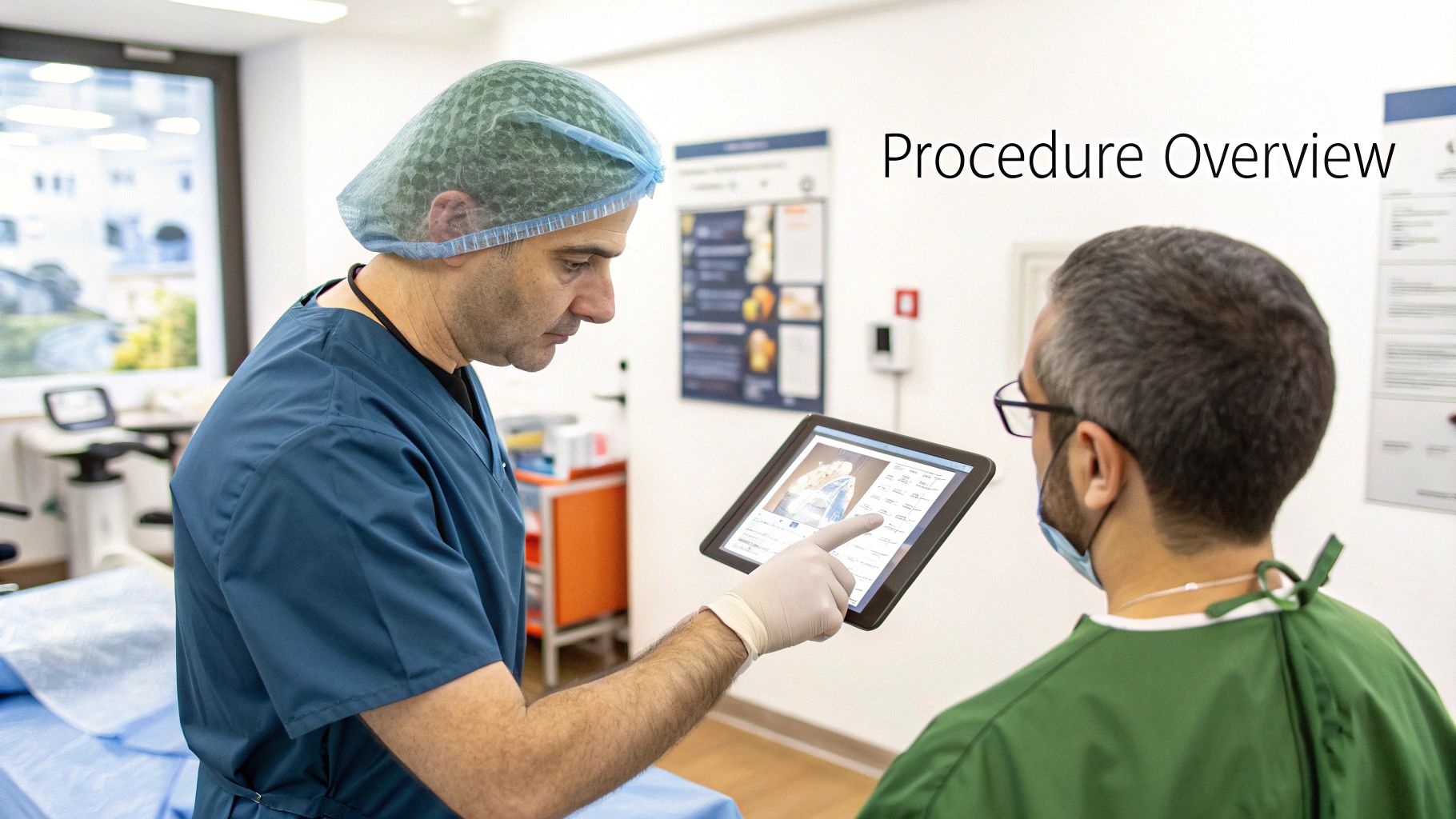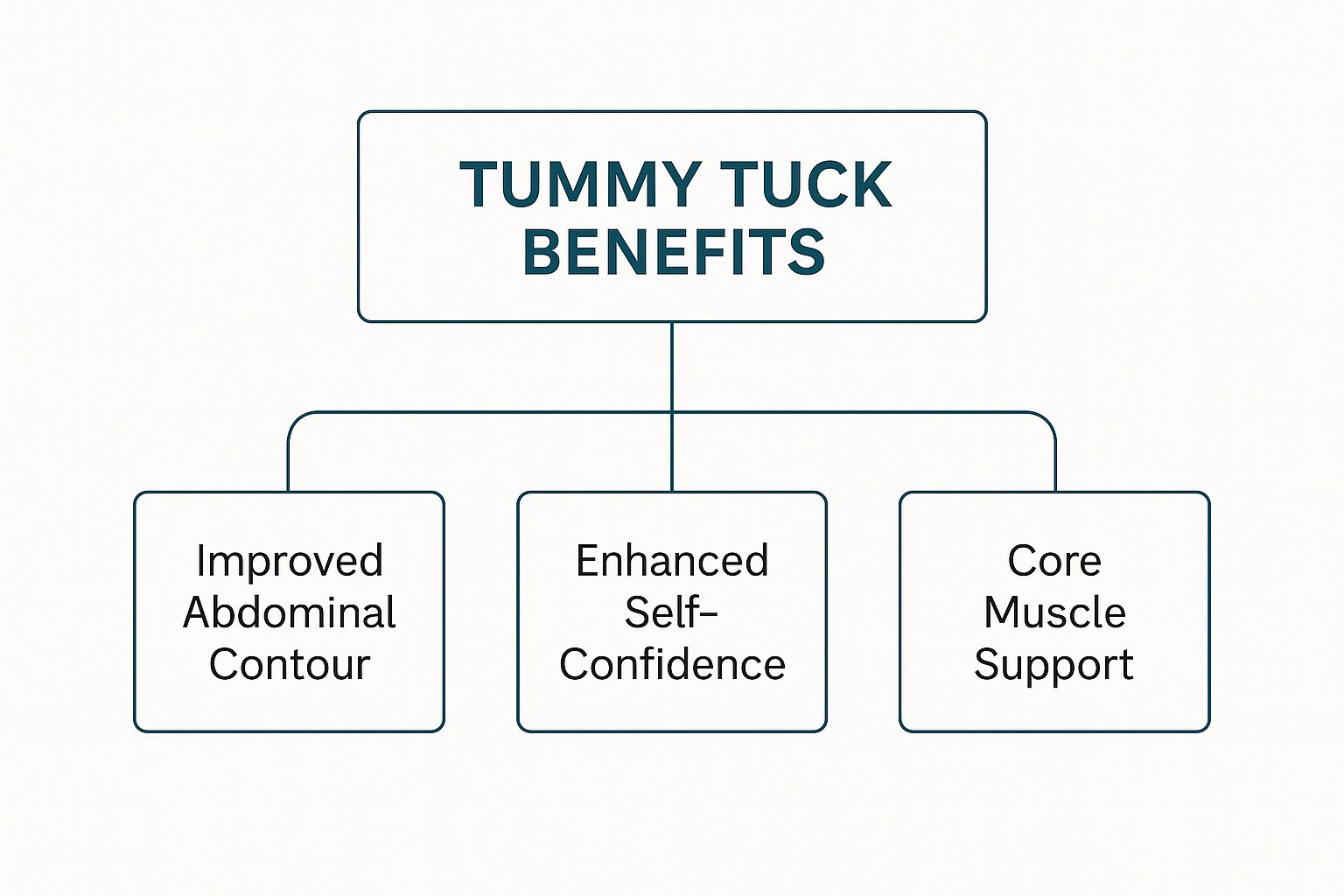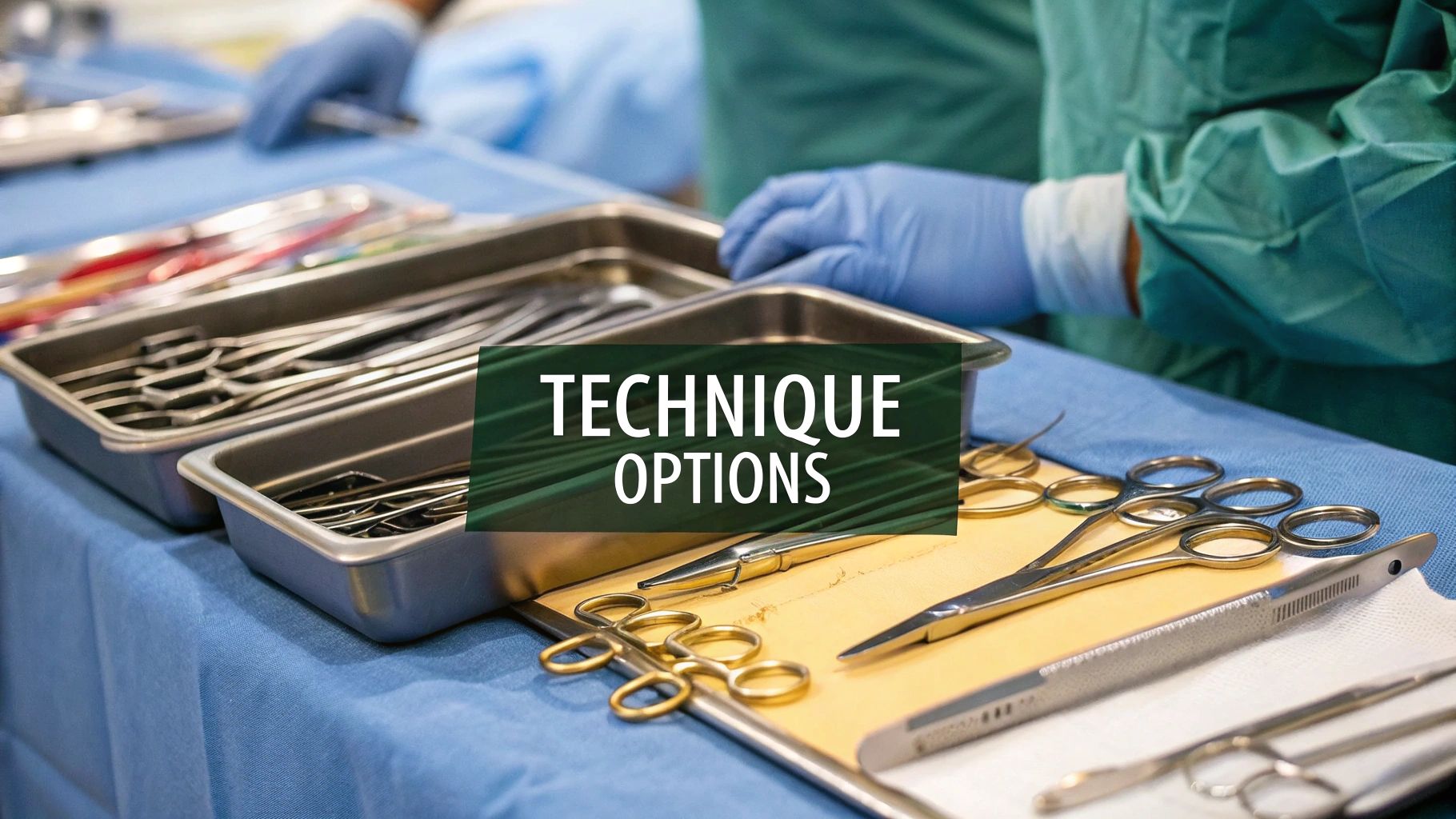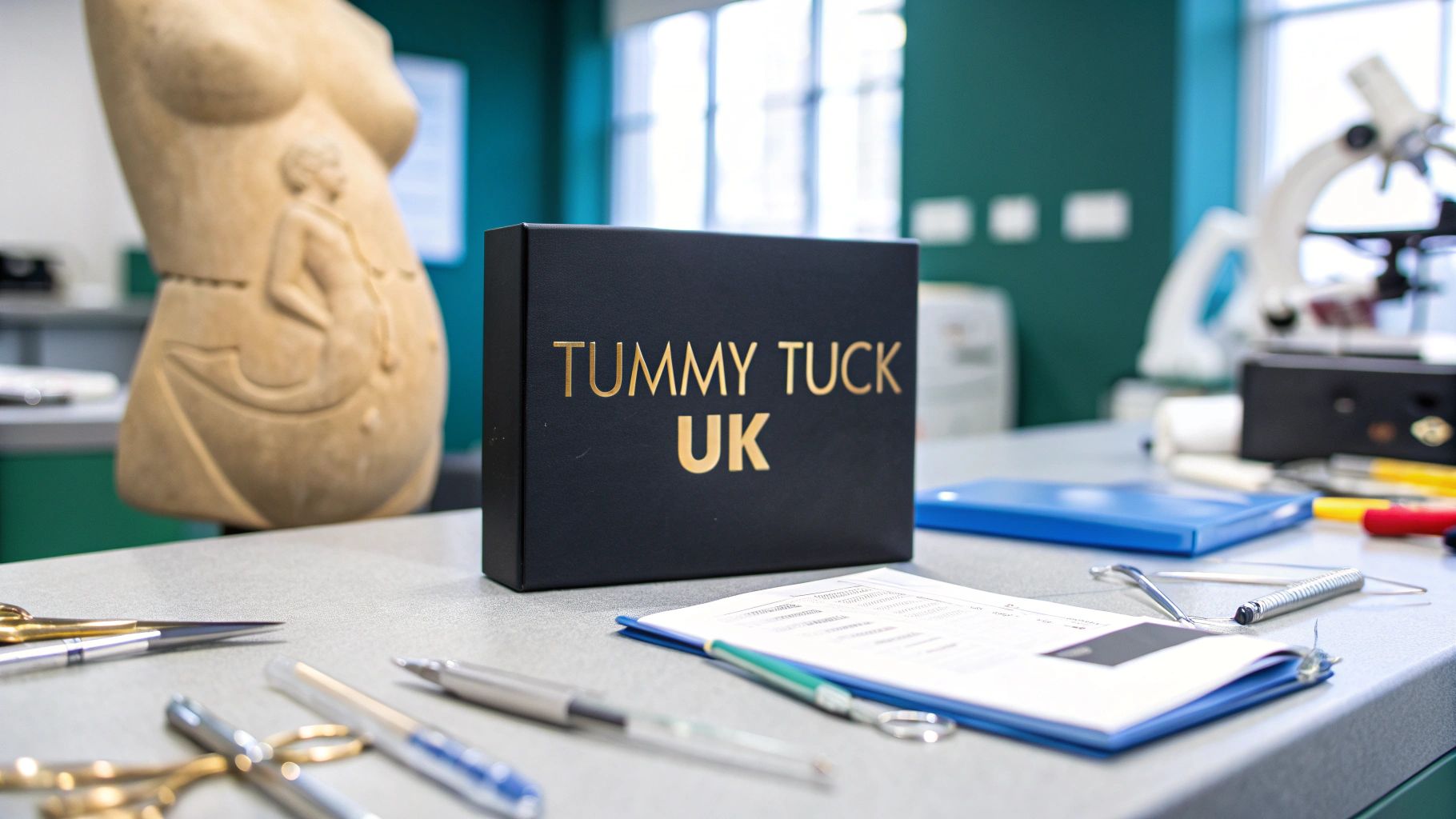.webp)
A tummy tuck, known in medical circles as an abdominoplasty, is one of the UK’s most trusted body contouring procedures, designed to create a smoother, firmer abdomen. It’s not a shortcut to weight loss, but a highly effective surgical solution for removing excess skin and repairing separated muscles—often the lingering results of pregnancy or significant weight loss.
For thousands of people every year, it’s the final step in restoring their body's core.

Think of trying to smooth out a piece of fabric that's been permanently stretched; no amount of pulling or folding will ever make it lie completely flat again. A tummy tuck works on a similar principle, surgically correcting anatomical changes that diet and exercise simply can't touch. It’s a body-shaping surgery, meticulously designed to restore both the form and function of your abdomen.
The procedure is particularly life-changing for people who are already at a stable, healthy weight but are left with loose skin or weakened core muscles—common legacies of major life events that dramatically alter the body.
The best candidates are those looking for a solution to specific physical issues, not just general weight reduction. A tummy tuck uk consultation is all about making sure your personal goals line up with what the surgery can realistically deliver.
So, who typically sees the best results?
A tummy tuck can be a great option for both men and women, although women currently make up a larger share of patients. To give you an idea of its popularity, there were 2,830 tummy tucks performed in the UK in 2023 alone. You can dive deeper into the trends over at Statista.
Deciding if surgery is the right step is a big decision. This table can help you quickly see if your situation aligns with what a tummy tuck is designed to address.
Ultimately, a tummy tuck offers a solution for deep structural issues that can't be resolved through other means. It’s a powerful procedure for those whose bodies have undergone profound changes.
It’s crucial to know the difference between a tummy tuck and liposuction. While liposuction is fantastic for removing stubborn pockets of fat, a tummy tuck goes a step further. It physically cuts away loose, excess skin and tightens the underlying muscle wall.
Think of it this way: liposuction is like clearing clutter out of a room, while a tummy tuck is like restructuring the very foundation and walls of that room.
A tummy tuck isn't about changing the number on the scales; it’s about changing the shape of your silhouette and restoring your core integrity. It targets the skin and muscle that no amount of crunches will ever fix.
By clarifying its true purpose, you can better decide if this surgical path lines up with your personal body goals and set yourself up for a truly satisfying outcome.
Let's get one thing straight: not all tummy tucks are the same. The term is really an umbrella for several distinct procedures, each designed to tackle different levels of concern. Think of it like getting a suit tailored—the best fit depends entirely on your unique shape and what you want to achieve. Getting to grips with the options is the first step towards having a really productive chat with your surgeon.
A tummy tuck uk specialist will look at your skin elasticity, the degree of muscle separation, and where any excess fat is sitting before recommending the best technique for you. Let's break down the three main types of abdominoplasty you'll find here in the UK.
A Full Tummy Tuck, or traditional abdominoplasty, is the most comprehensive choice. It's the go-to for people with significant loose skin and weakened abdominal muscles both above and below the belly button—something often seen after pregnancy or major weight loss.
The procedure involves a horizontal incision made low down on the abdomen, usually running from hip to hip. A second small cut is made around the navel to free it up. The surgeon can then pull the underlying abdominal muscles back together (this is called diastasis recti repair), remove a large section of excess skin, and reposition the belly button so it looks completely natural. It’s a complete overhaul of the whole abdominal area.
If your main concerns are located below your belly button, then a Mini Tummy Tuck could be the perfect solution. This is a less invasive technique, ideal for those who just have a small, stubborn pouch of fat or a little loose skin on the lower abdomen but otherwise have decent muscle tone.
The main differences are pretty clear:
Because it’s a much less extensive procedure, recovery is generally quicker compared to a full tummy tuck. It’s more of a refinement than a total reconstruction.
A good way to think about it is this: a full tummy tuck is like renovating an entire room, whereas a mini tummy tuck is like redecorating a single feature wall. Both improve the space, but the scale and impact are worlds apart.
For those who have excess skin that doesn't just stop at the abdomen but wraps around to the hips and flanks (what many people call 'love handles'), the Extended Tummy Tuck offers a more panoramic result. This is a very common procedure for patients who have undergone massive weight loss.
It essentially builds on the full tummy tuck by making the horizontal incision longer, extending it around the sides of the body. This allows the surgeon to remove excess skin from the flanks and upper hips too, creating a much smoother, more balanced contour from every angle. Yes, the scar is longer, but for the right person, the contouring results are far more dramatic.
Of course, surgery isn't the only option out there. For those exploring a full range of body contouring, it’s worth knowing that other advancements exist. For example, some people explore minimally invasive BodyTite procedures which can address moderate skin laxity and fat with less downtime.
The infographic below neatly illustrates the core benefits these surgical options aim to provide.

As you can see, the goals go beyond just aesthetics, also covering functional core support and the positive psychological impact. To get a better feel for the surgical pathways available, you can learn more about the scope of plastic surgery expertise offered by qualified professionals.

Deciding on a tummy tuck in the UK is a major step, and knowing exactly what lies ahead can turn a daunting prospect into a manageable and even exciting one. Think of it like a well-planned expedition; the more you understand the route, the more confident you'll feel about the destination.
Your journey doesn’t start in the operating theatre. It begins with a conversation. The initial consultation with your surgeon is arguably the most crucial part of the whole process. This is a two-way street—a chance for you to explain your goals and for the surgeon to assess what's realistically achievable for your body.
Don't hold back. This is the time to ask every single question that comes to mind, no matter how small you think it is. A great surgeon will always encourage your curiosity and give you clear, honest answers.
During this first meeting, your surgeon will carry out a physical examination, go through your medical history, and talk you through the different abdominoplasty techniques. It’s here that you’ll get a clear recommendation on which procedure is the perfect fit for your body and your aspirations.
To get the most out of it, come prepared with a list of questions. You might want to ask about:
This meeting is all about building a trusting relationship with your surgical team. Feeling prepared for the day itself is also key, which is why we’ve put together a guide on https://www.thevesey.co.uk/blog/how-to-prepare-for-surgery.
Your surgery day will be carefully orchestrated to make sure everything runs like clockwork. Once you arrive, you’ll meet the nursing staff, the anaesthetist, and your surgeon one last time to run through the plan and mark the incision lines.
The procedure is done under general anaesthesia, so you’ll be completely asleep and won’t feel a thing. A typical tummy tuck in the UK takes between two to five hours. Most patients can get back to daily activities and work within one to two weeks, with light exercise often possible after three to four weeks. You'll likely be cleared for more strenuous activity after 12 weeks.
Recovery is a phase of dedicated healing. It’s not a race, but a steady process of allowing your body the time and support it needs to adapt to its new contour. Patience during this period is your greatest asset.
Understanding the stages of recovery helps set realistic expectations and lets you plan your life around it. While everyone’s healing journey is unique, it usually follows a pretty predictable path.
The First 48 Hours
This is the most intense bit. You can expect swelling, bruising, and some discomfort, but this is all managed with prescribed pain medication. Your only jobs are to rest and take short, gentle walks to keep your circulation moving and reduce the risk of blood clots.
The First Two Weeks
You’ll be wearing a special compression garment around the clock to support your abdomen and keep swelling down. You'll still be moving cautiously and need to avoid any bending, lifting, or straining. Many people with desk jobs feel ready to return to work towards the end of this period, perhaps starting with half-days or working from home.
Weeks Three to Six
You’ll start to feel much more like your old self. Swelling will continue to go down, and you can slowly reintroduce light exercise, like longer walks or gentle cycling. The golden rule here is to listen to your body and your surgeon—no strenuous core exercises just yet.
Beyond Three Months
By the three-month mark, most of the swelling has vanished, and you can really start to see your final results taking shape. Once your surgeon gives you the green light, you can usually return to all your normal activities, including more intense workouts. Your scar will continue to mature and fade over the next year. To help with this process, some people find that in-home physiotherapy support is a fantastic way to regain mobility and strength as part of a personalised recovery plan.
Let's talk about one of the most practical questions on anyone’s mind: the cost. When you’re considering a tummy tuck in the UK, it's crucial to look past a single headline figure and get the full picture of what your investment covers. A good clinic won’t just give you a price; they’ll provide a transparent, all-inclusive quote, so you’re never left with hidden fees or surprise bills down the road.
Think of the total cost as a complete care package. It’s not just a fee for the surgery itself but a bundle of essential services designed from start to finish to ensure your safety and deliver the best possible result. A proper quote will almost always include several key components, each one playing a vital role in your journey.
When you receive a quote for your abdominoplasty, it should be a comprehensive figure that covers every single stage of the process. This approach is designed to prevent financial stress, allowing you to focus completely on your preparation and recovery.
Here’s a breakdown of what that fee typically includes:
This all-in, comprehensive approach means your care is seamless, from your very first consultation right through to your final check-up.
The final cost of a tummy tuck will always vary depending on the complexity of your specific procedure. It makes sense that a less invasive technique will have a different price point than a more extensive one. While prices naturally differ between clinics and surgeons, you can get a good idea of the general range for each type of surgery.
To give you a clearer idea, here is an overview of the potential costs you might encounter for different abdominoplasty procedures across the UK.
Of course, the final figure is influenced by a few key factors. The surgeon's experience and reputation play a significant part, as does the clinic's geographical location—for instance, prices in central London are often higher than in other UK cities.
A price quote is more than just a number; it's a reflection of the quality of care, the surgeon's expertise, and the level of support you'll receive. Investing in a reputable clinic is an investment in your safety and your final outcome.
On top of that, the specifics of your individual case, like how much skin needs to be removed and whether muscle repair is involved, will be factored into your personalised quote. Many clinics also offer financing plans to help make the procedure more accessible. For a detailed overview of what to expect, you can review a complete cosmetic surgery price list to see exactly how these costs are structured.

An honest conversation about what’s possible—and the potential risks involved—is the cornerstone of any good surgical journey. While a tummy tuck is a very safe and routine procedure, it's crucial to have a balanced perspective. Every single surgery, no matter how minor it seems, carries some level of risk. Understanding these upfront is key to making a confident, informed decision.
This isn’t to cause alarm, but to empower you. Think of it like a pilot's pre-flight check; reviewing every possibility is what ensures a smooth and safe trip. For a tummy tuck uk procedure, the risks are well-understood and managed effectively by experienced surgical teams.
The potential risks can be split into two main camps: those common to any surgery and those more specific to an abdominoplasty. A qualified surgeon will take every possible precaution to minimise these, but your awareness is the first step in prevention.
General surgical risks include:
Procedure-specific risks are also important to consider. These are directly related to the nature of the surgery itself and are managed through precise surgical technique and diligent aftercare.
These include:
Following your surgeon’s pre- and post-operative instructions to the letter is the single most important thing you can do to pave the way for a smooth recovery and minimise these risks. For more detailed guidance, our extensive patient information resources offer valuable insights to help you prepare.
With those risks in mind, it’s just as important to look at the other side of the equation: the results. There’s a reason tummy tucks remain so popular—the benefits are often profound, leading to exceptionally high rates of patient satisfaction.
For the vast majority of patients, the physical and emotional benefits far outweigh the manageable risks. The procedure resolves long-standing issues that diet and exercise alone could never fix, leading to a significant boost in confidence and quality of life.
While detailed satisfaction statistics in the UK can be hard to find, international data paints a clear picture. In the United States, for example, a staggering 95% of patients reported being satisfied with their results. This positive sentiment is mirrored in the UK, where the procedure's popularity has soared. One report even noted a 130% rise in a single year, reflecting just how much value patients place on the outcome.
Ultimately, a successful tummy tuck is a partnership between an expert surgeon and a well-informed patient. By understanding both the potential hurdles and the incredible rewards, you can approach your decision with clarity and confidence, ready to achieve the results you deserve.
Picking the right surgeon is hands down the most important decision you'll make on your tummy tuck journey. This isn’t the time to hunt for a bargain; it’s about prioritising skill, safety, and a genuine rapport. Your surgeon is your partner in this, and your choice will shape not just your results, but your entire experience.
Think of it like hiring a guide for a serious mountain climb. You need someone with a proven track record, all the right credentials, and a way of communicating that makes you feel supported and confident from start to finish. Let’s break down what you should be looking for.
Before you even think about portfolios or consultations, you have to confirm a surgeon's qualifications. This part is non-negotiable. In the UK, this means checking for specific registrations and memberships that prove a surgeon has met the highest standards of training and ethical practice.
First, your surgeon must be on the Specialist Register of the General Medical Council (GMC). This is the official confirmation that they have completed the rigorous training required to be a consultant plastic surgeon. After that, look for memberships with highly respected professional bodies.
Key organisations to look out for are:
A surgeon’s credentials aren’t just a formality—they are your guarantee of quality and safety. They show a deep commitment to the highest standards of medical practice and a career dedicated to the art and science of plastic surgery.
Once you’ve confirmed a surgeon's credentials, it’s time to look at their work. A reputable surgeon will have a comprehensive portfolio of before-and-after photos, which is your best insight into their surgical skill and aesthetic style. Don't just be wowed by one or two amazing results; look for consistency across many different patients.
It's also crucial to find photos of patients with a body type similar to your own. This gives you a far more realistic idea of what might be possible for you. Pay close attention to the details—the neatness of the scars, how natural the new belly button looks, and the overall harmony of the new abdominal shape. Seeing how a surgeon has helped others like you can be incredibly reassuring, and you can often find examples when exploring the background of a surgical team at a prospective clinic.
The consultation is where you find out if a surgeon is the right personal fit. It’s a two-way conversation. You should feel heard, respected, and totally at ease asking anything that comes to mind. A great surgeon will listen carefully to what you want to achieve, explain the procedure in clear, simple terms, and give you an honest opinion on what you can realistically expect.
Trust your gut feeling here. If you feel rushed, dismissed, or pressured in any way, that’s a major red flag. You should walk out of the consultation feeling informed and empowered, not confused or anxious. It’s a good idea to prepare a list of questions beforehand so you don’t forget anything important, from their specific experience with abdominoplasty to the fine details of your recovery plan. This meeting really sets the tone for everything that follows, so make sure you choose a surgeon who earns your complete confidence.
When you’re seriously considering a tummy tuck, the big picture starts to come into focus, but it’s the smaller, practical questions that often pop up next. This is where we get into the details that really matter for your personal journey.
Think of it as filling in the last few pieces of the puzzle. Getting clear, honest answers helps you build a complete and realistic understanding of what to expect, from start to finish.
The short answer is yes, but it’s all about location. A tummy tuck removes a large section of skin from your lower abdomen—usually, everything from your belly button down to the pubic line.
If your stretch marks are on that specific patch of skin, they’ll be gone for good. Any stretch marks on your upper stomach or flanks, however, will still be there. They might shift a bit lower after the skin is tightened, but they won’t be removed. Your surgeon will be able to give you a very clear idea of what’s possible during your consultation.
This is a big one. Surgeons across the UK are all on the same page here: you need to be at a stable weight that you can comfortably maintain for at least six months before your surgery. A tummy tuck is designed for body contouring, not for weight loss.
Reaching a stable, healthy weight is so important because big swings on the scale after your operation can really undermine your results. Most surgeons also look for a Body Mass Index (BMI) under 30 to make sure the procedure is as safe as possible and gives you the best aesthetic outcome.
From a purely medical standpoint, having a tummy tuck doesn't affect your ability to get pregnant or have a healthy baby. However, every reputable surgeon will strongly advise you to wait until you’re absolutely sure your family is complete.
Why? Because a future pregnancy will naturally stretch the abdominal muscles and skin all over again. This would unfortunately undo all the careful work done during the abdominoplasty, and you’d likely need another procedure to get back to your original results.
There’s no getting around it—a tummy tuck scar is permanent. But a skilled plastic surgeon is an expert in placing and closing the incision to make it as discreet as possible. The main scar runs horizontally from hip to hip, but it’s positioned very low down.
This careful placement means it’s usually hidden by most underwear and bikini bottoms. At first, the scar will look red and feel a bit raised. Over the course of a year or so, it will mature, soften, and fade into a much lighter, less obvious line. Your genetics, skin tone, and how well you follow your surgeon's scar care advice all play a part in how it ultimately heals.
At The Vesey, our expert team is dedicated to providing personalised care and exceptional results. If you have more questions or are ready to explore your options, we invite you to schedule a consultation.

